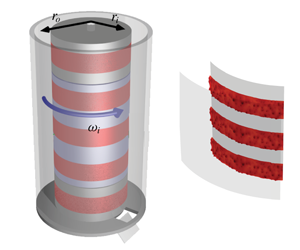JFM Rapids
The growth mechanism of turbulent bands in channel flow at low Reynolds numbers
-
- Published online by Cambridge University Press:
- 20 November 2019, R1
-
- Article
- Export citation
Is vortex stretching the main cause of the turbulent energy cascade?
-
- Published online by Cambridge University Press:
- 20 November 2019, R2
-
- Article
- Export citation
JFM Papers
Convection in a rapidly rotating cylindrical annulus with laterally varying boundary heat flux
-
- Published online by Cambridge University Press:
- 19 November 2019, A1
-
- Article
- Export citation
The entrainment and energetics of turbulent plumes in a confined space
-
- Published online by Cambridge University Press:
- 20 November 2019, A2
-
- Article
- Export citation
Characteristics of the pressure fluctuations generated in turbulent boundary layers over rough surfaces
-
- Published online by Cambridge University Press:
- 20 November 2019, A3
-
- Article
- Export citation
Depth-integrated wave–current models. Part 1. Two-dimensional formulation and applications
-
- Published online by Cambridge University Press:
- 20 November 2019, A4
-
- Article
- Export citation
The self-induced motion of a helical vortex
-
- Published online by Cambridge University Press:
- 20 November 2019, A5
-
- Article
- Export citation
Finite-size spherical particles in a square duct flow of an elastoviscoplastic fluid: an experimental study
-
- Published online by Cambridge University Press:
- 21 November 2019, A6
-
- Article
-
- You have access
- Open access
- HTML
- Export citation
Instability of forced planar liquid jets: mean field analysis and nonlinear simulation
-
- Published online by Cambridge University Press:
- 25 November 2019, A7
-
- Article
- Export citation
Effect of adverse pressure gradients on turbulent wing boundary layers
-
- Published online by Cambridge University Press:
- 25 November 2019, A8
-
- Article
-
- You have access
- Open access
- HTML
- Export citation
Progress in the second-moment closure for bubbly flow based on direct numerical simulation data
-
- Published online by Cambridge University Press:
- 25 November 2019, A9
-
- Article
-
- You have access
- Open access
- HTML
- Export citation
Solitary wave fission of a large disturbance in a viscous fluid conduit
-
- Published online by Cambridge University Press:
- 25 November 2019, A10
-
- Article
-
- You have access
- Open access
- HTML
- Export citation
Effect of flow topology on the kinetic energy flux in compressible isotropic turbulence
-
- Published online by Cambridge University Press:
- 25 November 2019, A11
-
- Article
- Export citation
Nonlinear dynamics of forced baroclinic critical layers
-
- Published online by Cambridge University Press:
- 25 November 2019, A12
-
- Article
- Export citation
The turbulent flow in a slug: a re-examination
-
- Published online by Cambridge University Press:
- 25 November 2019, A13
-
- Article
-
- You have access
- Open access
- HTML
- Export citation
Nucleation and growth dynamics of vapour bubbles
-
- Published online by Cambridge University Press:
- 25 November 2019, A14
-
- Article
- Export citation
Controlling secondary flow in Taylor–Couette turbulence through spanwise-varying roughness
-
- Published online by Cambridge University Press:
- 25 November 2019, A15
-
- Article
-
- You have access
- Open access
- HTML
- Export citation
Strongly nonlinear effects on internal solitary waves in three-layer flows
-
- Published online by Cambridge University Press:
- 25 November 2019, A16
-
- Article
- Export citation
Resolvent-based estimation of space–time flow statistics
-
- Published online by Cambridge University Press:
- 25 November 2019, A17
-
- Article
- Export citation
A theory for the slip and drag of superhydrophobic surfaces with surfactant
-
- Published online by Cambridge University Press:
- 25 November 2019, A18
-
- Article
- Export citation



































































